SABIC Collaboration Leads to TF-BOPE Frozen Food Packaging with Less Material Consumption
The innovative TF-BOPE film resulted from SABIC’s teaming up with two film converters and a packaging machine manufacturer.
SABIC recently announced a sustainable packaging solution for frozen food which combines one of its new PE grades with innovative film technology to produce a mono-web TF-BOPE (tenter frame biaxially oriented polyetheylne) film structure. This innovative frozen foods packaging solution resulted from SABIC’s close collaboration with two film converters—Italy’s Ticinoplast and Bulgaria’s Plastchim-T, and German-based packaging machine manufacturer Syntegon Technology.
Compared to conventional blown PE film solutions, it has been shown to offer significantly higher throughput and also has potential for down-gauging, making it attractive from both a commercial and sustainability standpoint. The thinner gauge reportedly provides a potential packaging material reduction of approximately 35-50% compared to incumbent blown PE film. The reduced thickness of the packaging solution minimizes environmental impact and supports brand owners and retailers who are aiming to reduce their packaging material consumption. This packaging solution is also 100% recyclable and fits mono-PE recycling streams.

Syntegon’s director of business, market and sustainability Pierre Hamelink,said: “This innovative packaging solution demonstrates the true value of collaboration. Stakeholders throughout the supply chain have had to work together to bring this to life: sustainability cannot be achieved single-handedly. Our research and development efforts are driven by our mission to deliver sustainability – without compromise. Our new PHS 2.0 sealing technology can process thinner films whilst offering the same level of sealing quality, product protection and processing speed as conventional sealing technologies. When replacing composite packaging materials on new and existing Syntegon machines with films made of SABIC’s BOPE, brand owners benefit from even more material and cost savings.”
TF-BOPE film is made of SABIC’s LLDPE BX202, launched at K2019, which boasts tear direction, low tear strength and provides an easy unidirectional opening. Compared to conventional solutions, it reportedly offers much better visibility of packaged products due to higher light transmission and lower haze. Meanwhile the high gloss delivers first-class design and aesthetics. The 20-micrometer thin film was successfully tested on Syntegon’s vertical form, fill and seal machines, which feature the PHS 2.0 sealing technology and said to reduce the amount of clamped film by 25% and increase packaging speed by up to 25%. The thin TF-BOPE film also requires less cooling time which increases packaging speed even more.
During the evaluations, a constant speed of 130 bags/min was achieved. For packers, TF-BOPE film delivers a robust sealing performance and increased productivity resulting from improved packaging speed. The thin gauge results in increased film roll efficiency which reduces logistic handling, storage space and transport costs. For converters and brand owners, SABIC’s TF-BOPE film material offers a wide range of benefits that include good printability, cost-saving opportunities, higher yield, less consumption of plastic materials and lower packaging taxes due to reduced material consumption. It further reduces the package weight to product weight ratio, resulting in a more optimized packaging design.
Related Content
-
For Extrusion and Injection-Blow Molders, Numerous Upgrades in Machines and Services
Uniloy is revising its machinery lines across the board and strengthening after-sales services in tooling maintenance, spare parts and tech service.
-
Get Color Changes Right In Extrusion Blow Molding
Follow these best practices to minimize loss of time, material and labor during color changes in molding containers from bottles to jerrycans. The authors explore what this means for each step of the process, from raw-material infeed to handling and reprocessing tails and trim.
-
Foam-Core Multilayer Blow Molding: How It’s Done
Learn here how to take advantage of new lightweighting and recycle utilization opportunities in consumer packaging, thanks to a collaboration of leaders in microcellular foaming and multilayer head design.









